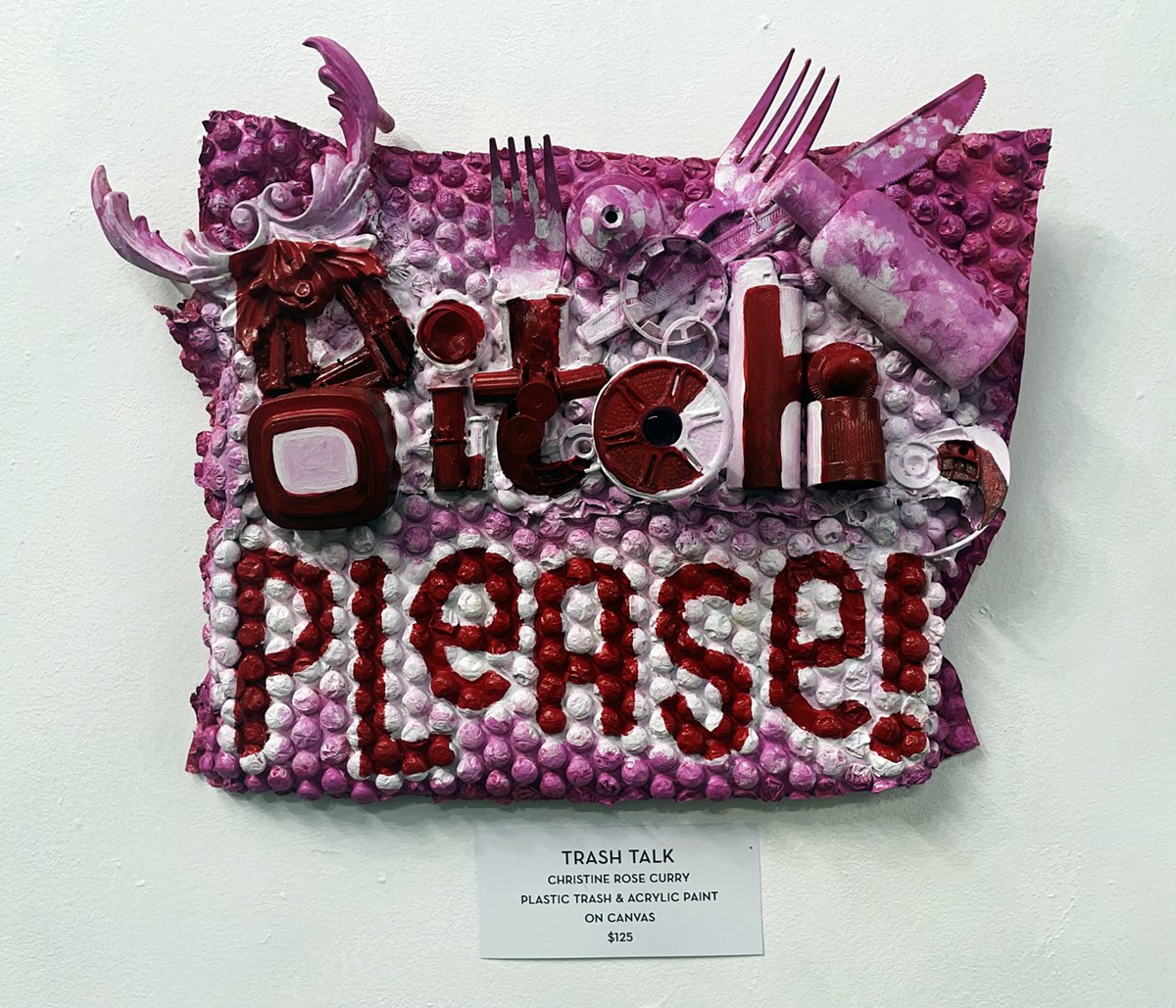Zip37 Reunion
Zip37 Reunion
Kanon Collective
6501 W. Colfax Avenue, Lakewood, CO 80214
October 4-27, 2024
Admission: free
Review by Dani/elle Cunningham
For more than twenty years, Zip37 was an artist-run gallery at 37th Avenue and Navajo Street in Denver and was part of what was then the Navajo Street Art District. Though that art district has declined, Zip37 and its many recognizable artists are celebrated in a new exhibition at Kanon Collective in Lakewood’s 40 West Arts District, where many Navajo Street galleries relocated. [1]
A view of the title wall in the Zip37 Reunion exhibition at Kanon Collective (from left to right), Jennifer Melton, Minaret, acrylic on canvas; Christine Rose Curry, Trash Talk, plastic trash and acrylic paint on canvas; Pat Cronin, Monster, ceramic wall sculpture; Mark Friday, Keeping Track, assemblage sculpture; and Jerry Simpson, Fang, mixed media sculpture. Image by DARIA.
Small, but featuring some artwork that was originally displayed at Zip37, the exhibition exemplifies the gallery’s upbeat spirit. Never much for hoity-toity, intellectual art, these artists demonstrate their skill and their love of making with a collection of brightly colored paintings and whimsical sculptures.
Christine Rose Curry, Trash Talk, plastic trash and acrylic paint on canvas. Image by DARIA.
Christine Rose Curry makes an appearance on the title wall with her signature wild, tacky-in-the-best-way style in Trash Talk, a pink and red wall hanging made from reclaimed plastics. The kitschy plaque features the phrase “Bitch, please!”—a punchy expression that epitomizes Curry’s sarcastic take on global trash production.
Jennifer Melton, Minerit, acrylic on canvas. Image by DARIA.
Pat Cronin, Monster, ceramic wall sculpture. Image by DARIA.
Curry’s work is surrounded by Jennifer Melton’s cheerful painting on the left, along with three-dimensional objects by Pat Cronin, Mark Friday, and Jerry Simpson on the right. Curry’s humor paired with Melton’s flat yet decorative painting of a towering building balances out the folksy horror of Cronin's Monster—a ceramic, matte black, chimeric head that induces suspense with its haunted eyes, horns, and slightly open mouth.
Mark Friday, Keeping Track, assemblage sculpture. Image by DARIA.
Similarly, Friday's Keeping Track, a rustic wooden shelf with assemblage, features an unsettling carved face, adding to the eerie yet compelling contrast.
Jerry Simpson, Fang, mixed media sculpture. Image by DARIA.
Simpson’s whimsical, found object assemblage rounds out the wall, combining objects like a padlock, lightbulbs, plastic beads, marbles, toy balls, and a cheese grater. The result is a chaotic yet elegantly shaped, otherworldly form that, much like Curry’s work, reflects on the need to make the most of our throwaway culture.
Brad K. Evans, Denver Fugly, acrylic on panel. Image by DARIA.
In addition to offbeat 3D work, the exhibition showcases the abundance of Zip37 artists skilled in two-dimensional mediums, ranging from printmaking to acrylic painting, ink, and pencil. Brad K. Evans’s Denver Fugly hearkens to the practice of razing old homes and replacing them with modernist monstrosities.
At the time of Zip37’s closing in 2017 and today, this practice had many in the Navajo Street area upset at their rapidly changing skyline. Evans’s small acrylic painting, depicting a dull geometric profile reminiscent of one of those architectural eyesores, evokes nostalgia while simultaneously critiquing the very era it reflects—a fitting commentary for this reunion show.
Reed Weimer, In Hand, linocut print. Image by DARIA.
Reed Weimer’s linocut In Hand uses expressive lines to depict a black bird, maybe a crow, perched atop a hand. The work is executed with simplicity, using flat, straight-from-the-tube colors that showcase the artist’s skill without resorting to the attention-grabbing flair of a more complex or flashier subject.
In keeping his work concise, Weimar reflects the ethos of the gallery, which he and others founded. Art should be fun, affordable, and for everyone—sentiments that unfortunately didn’t align with the high costs needed to cover rent. This social and cultural plague has impacted the Denver art community before and since the gallery’s closure.
A view of works by Reed Weimer, Candace Shepard, and Kym Bloom in the Zip37 Reunion exhibition at Kanon Collective. Image by DARIA.
Zip37’s reunion exhibition at Kanon Collective serves as both a tribute to the group’s legacy and a reminder of its lasting impact on Denver’s art scene. It brings together a collection of artists who, through their lively and accessible work, continue to embrace the spirit of creativity and community that defined the original gallery.
An installation view of the Zip37 Reunion exhibition at Kanon Collective. Image by DARIA.
While the Navajo Street Art District may have faded, the ethos of Zip37 remains vibrant in the works on display. This celebration not only reflects on a cherished past but also invites new audiences to experience the joy of art made by these titans of Denver art.
Dani/elle Cunningham (she/her) is an artist, scholar, and independent curator. She writes about science fiction, gender, sexuality, and disability, with an emphasis on mental illness. The co-founder of chant cooperative, an artist co-op, she holds a master’s degree in art history and museum studies from the University of Denver.
[1] From the Kanon Collective website.

















